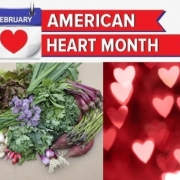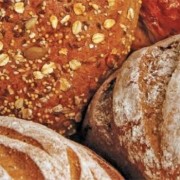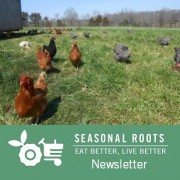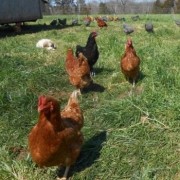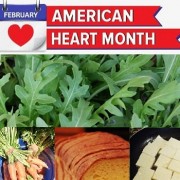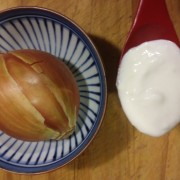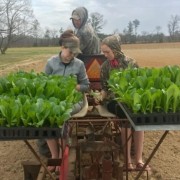American Heart Month & heart-healthy local food
This American Heart Month, show your heart some love!
– By the Veggie Fairy Team
While Valentines are nice, a healthy ticker is even better! February is American Heart Month, the perfect time to get in the habit of keeping heart-healthy foods on hand.
We’ve rounded up our top 10 heart-healthy, local foods. They’re all recommended by the American Heart Association, the National Institutes of Health, and the Cleveland Clinic. Some of these items are available year-round, and some are seasonal. So keep an eye out when you’re browsing our online farmers market. If you put a few of the foods on this list in your Seasonal Roots basket each week (not just during American Heart Month!) your heart will love you for it!!!

#1 Dark leafy greens
Leafy greens are a great source of fiber, antioxidants, vitamins, and minerals that contribute to heart health. Examples include kale, spinach, Swiss chard, arugula, and watercress. These tasty greens are grown locally all year round and can be used in a wide variety of recipes. Try using these greens in sandwiches instead of lettuce, or mix them up for a heart-healthy salad. We’ve got more ideas on how to cook greens, plus kale recipes for kids of all ages!

#2 Whole grain items
Opt for whole grains when you can. This applies to items such as pasta, breads, cereals, and crackers. In their original, unprocessed state, whole grains still have the outer layers that contain healthy vitamins, minerals, and fiber, plus carbohydrates, protein, and healthy, unsaturated fats. So grains like whole wheat, oats, and kasha provide more heart-healthy fiber than white flour. Bonus: They’re more filling too!

#3 Tomatoes
This versatile fruit masquerading as a vegetable can be added to most savory dishes — think salads, pastas, eggs, and sandwiches. In addition to antioxidants, tomatoes are high in potassium, which can help control high blood pressure.

#4 Red, yellow, and orange veggies
Many studies show that carrots, sweet potatoes, red peppers, and acorn squash are packed with carotenoids, fiber, and vitamins. These are all beneficial for your heart. So cook with color and eat the rainbow!

#5 Hummus
Legumes in general are great for your circulation, and hummus is chock-full of chickpeas. Chickpeas are also known as garbanzo beans, and they’re a type of legume. The olive oil in hummus is good for your heart, too! A study compared eating legumes once a week to eating legumes four times a week. The result: eating legumes four times a week was associated with a 22% lower risk of coronary heart disease.

#6 Berries
Everybody loves berries, and local berry season is coming soon! Strawberries, blueberries, raspberries, and blackberries are rich in fiber and antioxidants. This is especially true when you eat them in season — at their flavorful and nutritional peak. There’s evidence that getting your antioxidant vitamins from food is much more effective and beneficial than getting them from supplements. So go ahead and grab another helping of berries!

#7 Tofu
If you’ve never cooked with tofu, don’t be intimidated! Try tofu in a flavorful stir-fry with fresh veggies for a heart-healthy lunch or dinner. Research indicates that including more soy foods like tofu in your diet may have cardiovascular benefits, like lowering blood pressure. The prepared vegan meals in your online farmers market are a super-easy and tasty way to get your tofu. So go for it, whether your a tofu newbie or a tofu super fan.

#8 Asparagus
According to the NIH, asparagus is filled with mighty nutrients such as beta-carotene, folate, and fiber. This tender, sweet vegetable is delicious when roasted and drizzled with olive oil and a squeeze of lemon. Plus, asparagus only has 25 calories per cup (or about 5 calories per large spear) – win-win!

#9 Broccoli
Crisp, fresh broccoli florets dipped in hummus are an extra powerful snack with a whopping list of heart-healthy nutrients. The list includes vitamins C and E, potassium, folate, and soluble fiber. Soluble fiber helps lower total and LDL cholesterol levels by binding to bile in the gut (which is made up of cholesterol). Then it gets removed from the body along with the body’s waste.

#10 Dark chocolate & red wine
Since this is Cupid’s month, we veggie fairies are happy to report that dark chocolate and red wine are both good for your heart! (Based on personal experience, there are definitely some days when wine and chocolate are really good for mental health, too. Just sayin’…!) The Cleveland Clinic put dark chocolate up against red wine to see if one is better for you than the other. Find out which one was the winner here!
SO IN CONCLUSION…
Make American Heart Month last all year long. By eating these foods locally when they’re freshly made or in season, you’re maximizing the nutritional benefits for your heart. Other heart-healthy staples to keep on hand include nuts like almonds and walnuts, extra virgin olive oil, canned or dried legumes, and quinoa (a grain that’s a great source of protein and rich in fiber). So with a clink of our glasses of red wine we say: Here’s to your heart!
ABOUT SEASONAL ROOTS
Seasonal Roots is much more than an online market — we’re a community of farmers, artisans, and members. We’re all dedicated to eating healthy, buying local, protecting the environment, raising animals sustainably and humanely, and spreading joy to our friends, family, and neighbors.
Since 2011, we’ve been empowering our members to live better by eating better. That means more nutritious, flavorful food that’s good for us and good for the planet. Every week, we provide you with hand-picked local produce, sustainable meat and dairy, and hand-crafted artisan goods — all hand-delivered direct from Dirt to Doorstep®.
